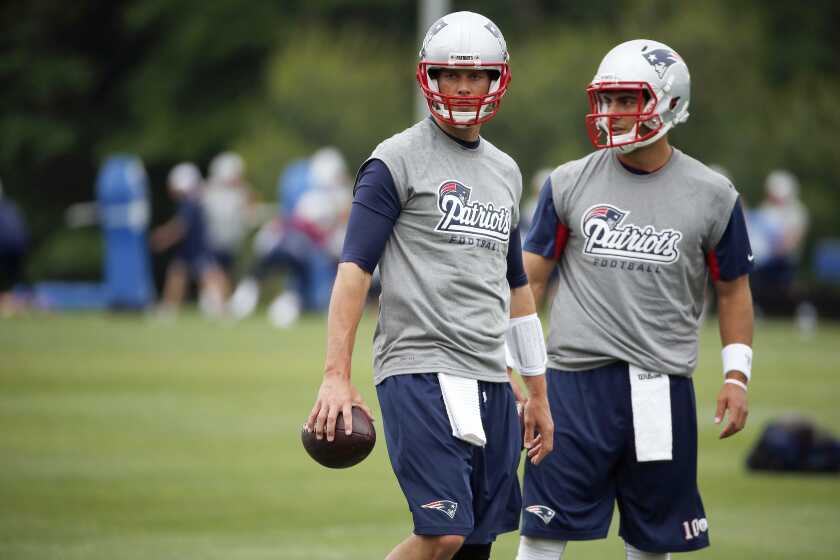Great Read: Golf designer digs up a classic at L.A. Country Club
The object of his search lay somewhere beneath the ground, two or three feet deep, maybe more.
Scanning old newspaper photos and aerial shots, Gil Hanse could only guess at where to begin. He fired up a bulldozer and started digging with a dexterity that belied so much steel and diesel.
“You’re almost part of the machine,” he said. “You can feel it in your hands and in your butt.”
The first few passes removed a substantial amount of dirt. After that, his task became more delicate. Thin layers of topsoil peeled away, a few inches at a time, until something brighter appeared — a patch of sand.
“Jackpot,” he recalled thinking. “It was like an archaeological dig.”
Except that Hanse is no archaeologist.
Sign up for our weekly Great Reads newsletter
On that winter day in 2009, the 51-year-old golf course designer had begun work at Los Angeles Country Club, launching into a project that — through fits and starts — lasted two years.
Not long after its completion, the exclusive club entered into negotiations to host the 2023 U.S. Open. Hanse’s renovation of the famed North Course gets much of the credit for bringing a major championship to this city for the first time in 75 years, but that was not his intention as he tore into the ground.
The subterranean cache of sand beside the 17th fairway belonged to a small bunker, a relic from the 1920s. Hanse was on a quest to revive a forgotten era in golf.
::
Everyone called him “The Captain,” a nod to his stint as a pilot in the Army Air Service during World War I.
George C. Thomas Jr. was a product of wealth, a man who could afford to spend his days breeding English setters, hybridizing roses and designing golf courses.
“These things were really his passion,” golf historian Geoff Shackelford said.
After designing several courses around his native Philadelphia, Thomas moved west in 1919, searching for a gentler clime in which to cultivate flowers.
Old footage shows him strolling through his Beverly Hills garden in a white Irish cap, a walking cane at his side. Southern California offered a chance to continue designing.
In a sport born on Scotland’s wind-swept links, he favored a natural style. The mental side of the game also appealed to him — his layouts constantly forced golfers to choose between risky shots or playing it safe.
In the early 1920s, he met William “Billy” Bell. Shackelford compares them to “a great songwriting duo,” with Thomas as visionary and Bell as the deft architect who could translate grand ideas onto hills and ravines.
They designed a handful of courses across Southern California, including Riviera Country Club and Bel-Air Country Club. After taking time off to write a book on golf architecture, Thomas accepted a project at Los Angeles Country Club in 1927.
The members wanted an extensive redesign of their grounds amid the burgeoning city.
“It will surpass Ojai, Riviera or any other of my former courses,” Thomas was quoted as saying. “I expect it may be my last.”
::
Seventy-eight years and numerous renovations later, only a faded outline of Thomas’ design remained.
To some degree, the North Course had fallen prey to the “Augusta effect.” As the Masters tournament grew popular on television, other clubs wanted that lush, manicured look, even if it didn’t quite fit the climate.
At Los Angeles Country Club, bunkers and greens were buried and rebuilt elsewhere. Rows of nonnative pines divided the expansive terrain into precise corridors.
“Tastes change,” the 43-year-old Shackelford said. “In the ‘50s and ‘60s, it was more about making things cleaner and streamlined. It kind of mirrored where society went with building architecture.”
The Southern California historian — who played on Pepperdine’s golf team — knew all about Thomas’ original blueprint, having collected documents and photographs while researching a biography published in 1996 called “The Captain.”
In 2006, when the club began interviewing architects to rejuvenate its aging North Course, Shackelford joined with the Pennsylvania-based Hanse to make a pitch. They suggested moving bunkers, uprooting trees and rerouting fairways to restore Thomas’ vision.
Such alterations would be a bold move for a club that consistently ranked in the Top 30 golf spots nationwide.
“The board embraced it, but not everyone else did,” said John Chulick, club president. “Whenever you make a big change, there are always going to be people who don’t agree.”
As membership wrestled with the idea, Hanse and Shackelford caught a break — the economy tanked, the club scaled back on its renovation budget and the board was able to push through a limited first phase.
Thomas was famous for his bunkers. Instead of oval shapes, they had chubby fingers like a baseball mitt. Instead of clean edges, they were rimmed by shaggy fescue.
“We needed a chance to show the members what it looked like,” Hanse said. “We needed to secure their trust.”
After uncovering the trap on No. 17, he went looking for more. Shackelford provided direction, borrowing additional documents from local universities and libraries. He said: “We found so many details … it helped convince people we weren’t nuts.”
As early construction neared an end, they clambered down into the refurbished bunkers to pluck at the edges by hand, ripping out tufts of grass for a rough-hewn look.
::
The true appeal of the North Course — the quality that ranks it among the nation’s best — is the land upon which it sits.
In those 325 acres tucked between Beverly Hills and Westwood, the terrain dips and turns, bisected by a winding barranca. Native sycamore and oak form a perimeter against high-rises encircling the property.
“To have this beautiful piece of ground preserved amid so much urban development is amazing,” Hanse said.
By 2010, the bunkers had been restored and the membership sufficiently impressed to approve more work. Hanse began removing nonnative vegetation, opening broad vistas.
From the elevated 17th tee, players could now gaze upon distant greens and fairways, getting a sense for how the land unfurled like a rumpled blanket and the barranca meandered through.
Bulldozers began excavating Thomas’ old greens. He often designed them with distinctive peninsulas and wings that allowed for varied pin placements.
A skilled crew member found their outlines by way of dark, mucky soil beneath the surface. In some cases, faint rings showed where the cups had been dug.
“We placed such an emphasis on historical accuracy,” Hanse said. “You didn’t want to destroy the evidence.”
Other quirks were revived. The 15th green had a mound dead-center — some members claim it was Thomas’ homage to the belly of the late Joseph Sartori, who co-founded the club around the turn of the 20th Century.
The original No. 17 was a short par-three that asked golfers to hit across the barranca to a deviously contoured green. The club abandoned this setup after the 1926 Los Angeles Open, in which pros struggled to make par in high winds.
Clearing tangles of sage, Hanse restored the oddity to serve as an alternate hole during tournaments or something extra for members to play before proceeding to the 18th tee.
“You look at the course now and it’s spectacular,” Chulick said. “I think people understand what we were trying to do.”
::
By most accounts, Thomas was charismatic, dapper in a manner befitting his lifestyle, though hardly flamboyant.
“He wasn’t breaking out in song and dance,” Shackelford said. “He got a lot done.”
In all, Thomas built or renovated about 15 golf courses before dying at age 58 from a heart attack. His “Golf Course Architecture in America” is considered an authoritative text and his name is mentioned beside such luminaries as Alister MacKenzie, Donald Ross and A.W. Tillinghast.
“The Golden Age of golf course design,” Hanse said.
Just as Thomas predicted, the North Course was his last full project. For years, it remained largely hidden within the gates of a very private club. Hanse’s renovation helped change that. Members now wanted to show it off.
After repeatedly saying no to the U.S. Golf Assn., which runs the Open, they acquiesced last year.
“This is a wonderful thing for golf,” said Tom O’Toole Jr., the USGA president. “Just a special opportunity.”
Over the next few months, Hanse will return to the club to work on the South Course, which Thomas started to redesign but did not live to finish. With no real documentation, Hanse will have to guess at what it might have looked like.
Jobs like these don’t come along often, the architect said. He must climb inside the mind of a celebrated designer.
That means poring over old photos. It means driving the bulldozer himself.
Twitter: @LATimesWharton
MORE GREAT READS:
At the ‘Mostly Lost’ festival, silent-movie buffs aim to name that film
Owner takes action after DWP bloodies his dog
How a transgender man tries to honor his Muslim faith
More to Read
Go beyond the scoreboard
Get the latest on L.A.'s teams in the daily Sports Report newsletter.
You may occasionally receive promotional content from the Los Angeles Times.











